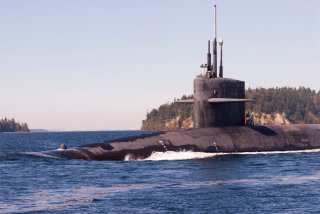No More Stealth: Are Submarines Losing the Element of Surprise?
For decades, analysts have predicted that a technological revolution would overtake undersea warfare. Is that finally occurring?
But what if they’re no longer unseen? If the sub and its human crew must keep their distance to avoid anti-access defenses, will UUVs—robots without human intuition and powers of observation—provide an adequate substitute? If not, strategies like “archipelagic defense” in Asia could underperform. If subs and their robot fleets can’t close narrow seaways to surface and subsurface traffic, the outlook for strategies premised on controlling them could prove dim. Thinking ahead about workarounds is imperative.
The situation isn’t entirely bleak for submariners, thankfully. While a leap in underwater detection technology may be in the offing, Clark points out that the U.S. Navy enjoys a first-mover advantage in other technologies that may help offset the loss of stealth or otherwise augment subs’ efficacy. UUVs capable of extending the submarine’s reach and lethality figure prominently among the new hardware. A torpedo boasting ten- or twentyfold the range of today’s ten-mile torpedoes would help redress the imbalance between subs and access deniers. So would a new Tomahawk anti-ship missile.
It’s highly doubtful, moreover, that the tactical setting will go kerchunk—like throwing a breaker—with subs accustomed to lurking underwater with impunity suddenly thrown in full view. More likely, the vicissitudes of naval competition being what they are, the subsurface theater will come to resemble the aerial and surface theaters. The silent service will periodically introduce new passive and active measures to restore its advantage of concealment, while access deniers will experiment with countermeasures of their own. And on and on the cycle of one-upsmanship—of challenge and reply—will go.
In short, submariners will no longer be as exceptional as before. They’ll have to learn new habits. They’ll be more like surface officers, forced to train for active defense and counterattack for survival rather than trusting to invisibility. They’ll have to be more like aviators, operating squadrons of offboard craft to extend their combat reach. And subs will no longer be loners, sent forth to do great things in independent operations. In short, not just a technological but a cultural revolution is afoot.
Embrace it.
James Holmes is J. C. Wylie Chair of Maritime Strategy at the Naval War College and author of “Visualize Chinese Sea Power,” in the current issue of the Naval Institute Proceedings. The views voiced here are his alone.
(This first appeared in June 2015 and is being reposted due to reader interest.)
Image: Flickr.

